Make
Oct, 4. We came together to make the idea from Dana and Claire an actual physical box that day. I grabbed a box from my dorm which was once a container for the biscuits I ordered and the good news is that it was useful as the main part of this project. Our initial idea was to make the project only a box dirty and full of trash from the inside and all pretty and colorful from the outside,but then we thought: How can we make it interactive? Claire suggested we can make it interactive by designing a trigger response: we throw trash in it and something beautiful, like flowers, pop up in response. 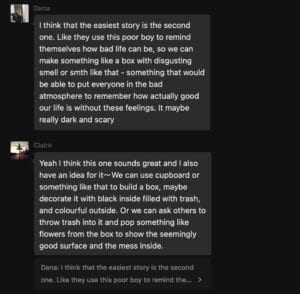 But then an even better idea came up: we can make someone put it on his/her head, and as he/she puts it on, flowers pop up, suggesting that he (the poor little boy in the book The Ones Who Walk Away From Omelas by Ursula K. Le Guin) and his suffering inside the box is the reason why all the happiness pops up. So then we decided make the presentation into a performance that plays out the story in the city of Omelas.
But then an even better idea came up: we can make someone put it on his/her head, and as he/she puts it on, flowers pop up, suggesting that he (the poor little boy in the book The Ones Who Walk Away From Omelas by Ursula K. Le Guin) and his suffering inside the box is the reason why all the happiness pops up. So then we decided make the presentation into a performance that plays out the story in the city of Omelas. 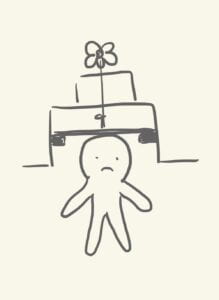 Harrison volunteered to be the poor little boy; Claire suggested that she could be one of those who leave Omelas; Dana thought that she could be the one who feels bad for the suffering boy but still returns back to her happy life eventually, and I thought that I could be the child while Jenna could “my mom”, and telling me about this poor little boy on my eighth year old birthday for the first time in “my” life. All of this plot and ideas all occurred to us in a sudden, while we were sticking white papers onto the the a-bit-too-fancy biscuit box to cover the patterns and then draw our own flowers on it. I also have to mention that every one of us was in charge of some particular parts of the whole work:
Harrison volunteered to be the poor little boy; Claire suggested that she could be one of those who leave Omelas; Dana thought that she could be the one who feels bad for the suffering boy but still returns back to her happy life eventually, and I thought that I could be the child while Jenna could “my mom”, and telling me about this poor little boy on my eighth year old birthday for the first time in “my” life. All of this plot and ideas all occurred to us in a sudden, while we were sticking white papers onto the the a-bit-too-fancy biscuit box to cover the patterns and then draw our own flowers on it. I also have to mention that every one of us was in charge of some particular parts of the whole work: 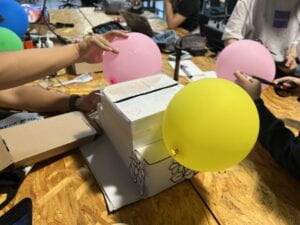 Claire and I were putting white A4 papers onto the box and trimming the extra cardboards that were sticking out. Jenna joined us later on, drawing those cute little flowers, cutting them out and adhering them to the box as a great decoration. ana was writing all our ideas down on her notebook and there is a photo below showing her neat notes and her drawing out the “Omelas” sign to put on stage so that the audience can better get the idea of “leaving the city Omelas”. And Harrison was suggesting that he could fix two cardboards sticking out from the inside to hold the piece of cardboard inside the box and below is a photo of him doing this key step.
Claire and I were putting white A4 papers onto the box and trimming the extra cardboards that were sticking out. Jenna joined us later on, drawing those cute little flowers, cutting them out and adhering them to the box as a great decoration. ana was writing all our ideas down on her notebook and there is a photo below showing her neat notes and her drawing out the “Omelas” sign to put on stage so that the audience can better get the idea of “leaving the city Omelas”. And Harrison was suggesting that he could fix two cardboards sticking out from the inside to hold the piece of cardboard inside the box and below is a photo of him doing this key step.
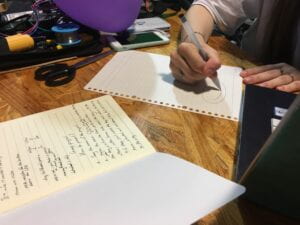
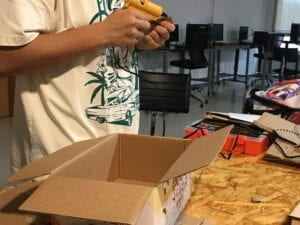
When we were wondering where we could get the flowers, it came to me that I happen to have some homemade weaved flowers back at the dorm. 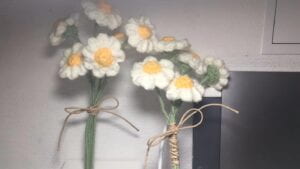 As I showed them the photo of the flower I made, we all agreed that the flowers can probably work and I shall bring it next time we get together. So we agreed to make some holes on the cardboard inside and leave it that way until I get the flowers. And after that, we simply went over the plot and the lines we were planning to say.
As I showed them the photo of the flower I made, we all agreed that the flowers can probably work and I shall bring it next time we get together. So we agreed to make some holes on the cardboard inside and leave it that way until I get the flowers. And after that, we simply went over the plot and the lines we were planning to say.
Oct, 6. One day before the presentation. That day we got together and I brought my flowers with me. Alaia came first and so we started first before others arriving. As we wanted the flowers to be interactive, the flowers should fall right back under the covers as the little boy takes off this box from his head. So we first came up with the idea that we could tie a rock or something heavy to it to make it fall right back. But unfortunately, after a round of search, all we got was a roll of irons that was supposed for the melting material in the soldering process. And it turned out it didn’t work well, supposedly it wasn’t heavy enough. After failing that attempt, I actually thought about sticking the “roots” of the flower “stems” onto a slice of cardboard,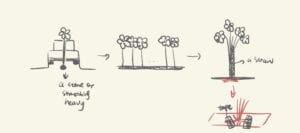 but didn’t shared that idea to our group because it then came to me that the “roots” and the cardboard only have a small space of joint parts, and even if we managed to stick them onto that cardboard, it won’t be able to last long, not to mention that the flowers have go all the way through two sheets of cardboards and the “stems” are definitely not “strong” or firm enough to make it all the way up. At last, I think it was Claire that suggested we could probably pull the end of the “stems” apart (as it is shown in the sketch I drew above) so that the “roots” could be firmly attached to the cardboard inside the box, and the flowers could move smoothly with the cardboard as Harrison puts it on his head. Hooray! The most important part of this interaction project is finally done!
but didn’t shared that idea to our group because it then came to me that the “roots” and the cardboard only have a small space of joint parts, and even if we managed to stick them onto that cardboard, it won’t be able to last long, not to mention that the flowers have go all the way through two sheets of cardboards and the “stems” are definitely not “strong” or firm enough to make it all the way up. At last, I think it was Claire that suggested we could probably pull the end of the “stems” apart (as it is shown in the sketch I drew above) so that the “roots” could be firmly attached to the cardboard inside the box, and the flowers could move smoothly with the cardboard as Harrison puts it on his head. Hooray! The most important part of this interaction project is finally done!
Let us move to the next part: the play we’re acting out. As Alaia just joined in, I suggested that maybe Jenna, she and I can form a lesbian family, and also a good way to show the liberty and happiness in the city of Omelas. We actually didn’t know what to say, and we were simply acting out the horror, shock and sadness as the response to seeing the dirty and poor little boy. And it was Harrison that suggested that we can act out how badly we treat him by saying something mean to him, and the mean action from everyone resulted in the mental collapse of him. He also proposed the great idea of showing this collapse by suddenly falling onto the floor from the standing position and that idea was eventually adopted on stage. And it was Claire herself that suggested that she could probably try to put the box on her head as a clearer sign to show empathy. We all agreed that it may be easier for the audience to understand this act so we adopted it as well. After going through the details, we ended that session and planned to rehearse for the last time before recitation starts.
Oct, 7.
During the last rehearsal, Harrison found that we may be lacking some description of the whole story and its background, but we actually thought of having a narrative at the very beginning. However, I think we then recalled the rule of “Set the Stage, Then Shut Up and Listen” (Tigoe 2012). So we decided that we shouldn’t have a narrator to interpret everything for the audience and should give the audience some space to think of it and interpret it in their own way. But now after hearing the feedback and reflecting on our thinking process, I feel like this play is actually very different from a single piece of interactive art. What we have is a story, and what we’re doing is just acting out our own interpretation of the story. We shouldn’t let our lack of description negatively affect the audience’s experience of watching the play. Although it is a huge mistake, I’m also glad that we can actually learn something valuable from this whole process.
Perform!
To be honest, I think that our group members all did their best job when we were actually on stage, and I promise that our performance that time was the best of all attempts. As a good beginning, Dana started loud and clear, showing the boundaries of the city of Omelas with the signs “Omelas” and “not Omelas” (for the audience to better understand what clear was doing by “leaving” Omelas). And then I wanted to dance around Harrison to show the happiness as a citizen of Omelas, but I also saw Harrison eyeing me, reminding the background information I was supposed to deliver. So I circled halfway to the other side of the stage and said, “Our lives are really happy, but our happiness is based on something DARK…” And then followed by Dana saying “And we chose him for all the suffering in our city.” And as she put the box onto Harrison’s head, he fell onto the floor, yelling “OHHH, NOT ME!” just as we agreed on the rehearsal. We then continued to dance around the poor bot in a circle to show our happy lives without any thing to worry. (But when I’m writing this sentence and rewatching our performance, I realize we should probably add more ways to show our felicity, and also ignoring the little boy’s suffering while doing those activities. For example, we can actually unfold and spread the picnic blanket we prepared for picnic, and covering the little boy as if he was not there. What I also learned is that it is always useful to review the rehearsals for any presentation before actually performing. In that way can we really get to the audience’s perspective and find space for progress.)
Then closely followed the conversation of our lesbian family, with my “mommies” telling me about they had to inform me of the existence of the poor, dirty, nasty little boy on my eighth year old birthday and also their tenth anniversary, and that the boy’s suffering is the exact reason for our happiness. Out of curiosity, “I” stepped up to see what the boy was actually suffering from by flipping up one side of the wings and I acted terrified by backing off quickly with my hands covering my face upon seeing the scary look of the little boy inside. But everything returned to normal as I get back to the happy environment.
Dana acted as the one who feel sorry and sad for the boy after seeing him, maybe the character also thinks that what the citizens doing-basing their happiness on one’s suffering-is wrong, but doesn’t actively think about changing this situation and re-joins our happy group later on.
And the final one is Claire, who acted as the one who leaves the city of Omelas. She has the strongest sense of empathy and showed it by putting the box on her head. And we got to know what the boy was actually suffering inside from her words, which are “dark” and “dizzy”. Indeed, the place where the little boy lives in the story is always dark without windows for light to come in, and he must have felt the world always spinning as he can neither think straightly nor think like a human in such a terrible environment. However, having experienced what the boy experiences, she still didn’t decide to save the boy, instead, after taking the box off, she put it right back onto the boy, saying “What a poor boy. Maybe you need to suffer from this. But I’m no longer going to live in Omelas.” So she left, and everyone else continues to dance and live happily, knowing the existence of a boy in the dark.
Feedback
After going through all the feedbacks from the video record above, I think the questions mainly focuses on three aspects: What is this box? How is it related to the story? and How is it interactive? I think the solution to the first two problems of not getting the audience to understand it (and basically the whole interactive part) is clearly suggested by Professor Minsky: we should clarify the background and probably how we got to the thought of the box before the play starts, but I’m also not sure how it will affect the performance, as it is supposed to have a deep and profound meaning, which may be hard to understand but supposedly CAN be understood if one digs deep in. Or probably the idea of this whole project just doesn’t fit for a stage like this, and we failed to take that into account. But I think what I’m certain is that we definitely should have watch our recorded video of rehearsals so as to find the really serious problem that we have of not getting our ideas across. And that also brings us to the last problem of failing to show how interactive it is during the play, rather than afterwards in the feedback session. Maybe we can ask Claire to try to put the box on for multiple times, back and forth, to show how scared and panicked she is, and at the same time showing the interactive flowers popping up while she does that repeatedly.
Analysis of Another Group
I really like the performance from group one. Compared to our performance, there are more fun and daily conversations in their performance. Although I don’t know whether it can be related to our daily lives, because the prompt asks us to design an imaginary interactive artifact that needs to be part of the environment, situation or the universe which the narrative of the story takes place in, I still really enjoyed their performance. Their idea of an interactive helmet that has two modes-rational and emotional or empathetic-relates to me a lot. And the three situations where the conversation takes place can clearly showcase the “interactive” part of this artifact. However, what I am expecting is something that shows its interactivity not through “acting it out” but through some designed-in feedbacks. This is probably only from my own perspective and I certainly know interaction can be of different kinds, and also there is a limit of using electronics, which makes it harder for the artifact to “talk back”. In brief, the lines and scenes they design are worthy of compliment and we can in fact learn from them to improve our performance in this aspect.
Conclusion
Although our final project and performance can be far from perfect and we also didn’t manage to get the expected feedback from the audience, we worked as a group, in which everyone actively participated and contributed in one’s own way. I also learned the preparations before presentations we should make and this valuable experience is definitely going to prepare me with skills and strategies that I will put into use in my future group projects.
